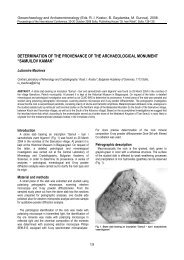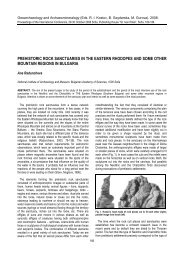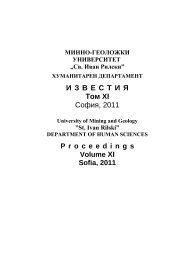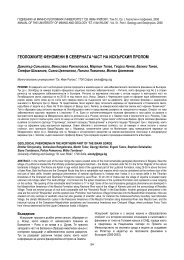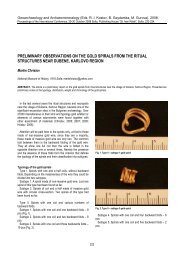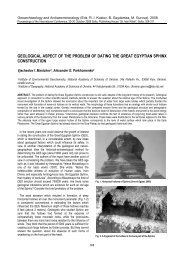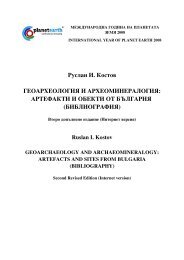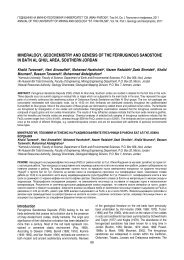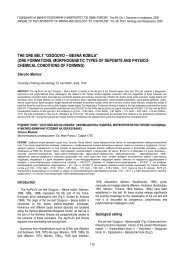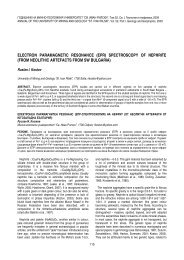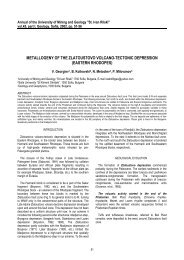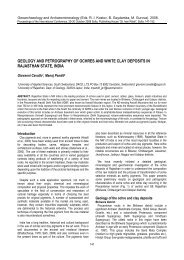FORMAL EARLY NEOLITHIC FLINT TOOLKITS ...
FORMAL EARLY NEOLITHIC FLINT TOOLKITS ...
FORMAL EARLY NEOLITHIC FLINT TOOLKITS ...
You also want an ePaper? Increase the reach of your titles
YUMPU automatically turns print PDFs into web optimized ePapers that Google loves.
Chronological and spatial features of the formal<br />
toolkits<br />
In order to put the discussed problem in adequate<br />
chronological framework, we present the division of the Early<br />
Neolithic in Bulgaria, according to the recent study on absolute<br />
dates (Boyadziev, 1995, 179): Early pottery (‘monochrome”<br />
phase) 6300/6200 – 6000/5900 cal BC; Early (‘classical”<br />
phase) 6000/5900 – 5500/5450 cal BC. Regarding the time<br />
span of the toolkits under discussion and their function, it is<br />
useful to point out that they are abundant during the whole<br />
“classical” Early Neolithic Karanovo I and II periods of the Tell<br />
Karanovo sequence, or until ca 5500 cal BC. On the other<br />
hand, in terms of their lasting ‘retardation’ in the same<br />
sequence, the end of the Karanovo III period at Tell Karanovo:<br />
5500-5280 cal BC (Görsdorf, 1997, 379) can be regarded as a<br />
terminus ante quem for the presence of formal toolkits.<br />
Spatial distribution of the formal toolkits<br />
Local distribution<br />
The formal toolkits are commonly found in the vast area of<br />
the Karanovo I and II cultures and their constituent regions in<br />
Southern Bulgaria: Thrace – the Tells Azmak, Karanovo and<br />
Kapitan Dimitrievo, and the Yabalkovo site; the Northern<br />
foothills of the Rhodope Mountains – the Rakitovo site, the<br />
Sofia Plain – Slatina; and the valley of Struma – Kovačevo<br />
(Fig. 2). The map shows sites in Western Bulgaria, which have<br />
been published (Gatsov, 1993). Other research has been<br />
undertaken by the author, and some of this work is still in<br />
progress (Gurova, 1997, 2001, 2001, 2004, 2005, in press). In<br />
North Bulgaria the flint industry exhibits a very different pattern<br />
30<br />
(exclusively expedient in character and an absence of the<br />
formal tools under discussion here), despite the fact that a<br />
proportion of the artefacts were made of the same raw material<br />
as used for the manufacturing of the discussed formal tools.<br />
Two sites belonging to the “monochrome” phase of the Early<br />
Neolithic sequence are marked in blue in recognition of their<br />
important position in the context of the Neolithisation debate.<br />
Supra-regional distribution<br />
Formal toolkits as a distinguishable category of the Early<br />
Neolithic flint repertoire have never before been discussed in<br />
the literature on the complex technological and social<br />
dimensions. Nevertheless some aspects of their stylistic<br />
‘coherence’ have often been observed in the course of work on<br />
different assemblages from adjacent major cultural areas –<br />
Proto-Sesklo, Starčevo and Körös-Criş. The most common<br />
feature mentioned in these studies is the presence of raw<br />
material from the Pre-Balkan platform among the Early<br />
Neolithic assemblages from the Balkans.<br />
According to C. Perlès a characteristic feature of the<br />
chipped-stone assemblages of Neolithic Greece is the<br />
“predominant use of non-local raw materials often obtained<br />
from considerable distances” (Perlès, 2001, 201). Recently,<br />
interesting and promising research has been done by G.<br />
Filippakis on the north Greek Neolithic assemblages, coming<br />
from outside the obsidian area. I hope our further study and<br />
collaboration will lead to positive issues of reliable comparison<br />
of the assemblages from both regions – Bulgarian Thrace and<br />
Greek Macedonia.<br />
Fig. 2. Map with Early Neolithic sites: triangles without numbers – western group studied by Gatsov; grey triangles – study and direct observation of the<br />
author; numbers 9 &10 – ‘monochrome pottery’ sites. The three main flint outcrops are indicated by white signs in relation to modern cities. Arrows<br />
indicate presumed directions of: spread of Neolithisation – black; distribution of Dobrudzha flint – white. Numbered sites: 1 – Kovačevo; 2 – Slatina; 3 –<br />
Rakitovo; 4 – Kapitan Dimitrievo; 5 – Yabalkovo; 6 – Azmak; 7 – Karanovo; 8 – Dzhuljunitsa; 9 – Koprivets; 10 – Ohoden



